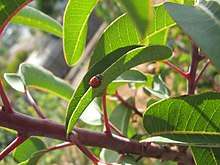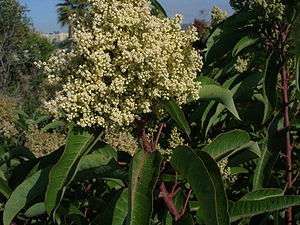Malosma
Malosma is a plant genus which contains only a single species, Malosma laurina, with the common names laurel sumac and lentisco (Spanish).[1] Malosma laurina is found along the southern California and Baja California coasts of the Pacific Ocean.
| Malosma | |
|---|---|
 | |
| Malosma laurina, the Laurel sumac | |
| Scientific classification | |
| Kingdom: | Plantae |
| Clade: | Tracheophytes |
| Clade: | Angiosperms |
| Clade: | Eudicots |
| Clade: | Rosids |
| Order: | Sapindales |
| Family: | Anacardiaceae |
| Subfamily: | Anacardioideae |
| Genus: | Malosma Nutt. ex Abrams |
| Species: | M. laurina |
| Binomial name | |
| Malosma laurina (Nutt.) Nutt. ex Abrams | |

Description

Malosma laurina is a large, rounded evergreen shrub or small tree growing 3 to 5 meters (10–15 feet) tall.
The leaves have a taco shell shape. When flattened, they have the shape of laurel leaves, with lance-shaped leaf blades up to 10 cm (4") long. The tips of the stems, little stem attaching the leaf to the stems (petiole), the veins of the leaves, and the edges of the leaves, are a glowing reddish color all year long.
The fragrant leaves and stems give chaparral its characteristic fragrance. The leaves and stems are full of volatile compounds that give it the scent. Laurel sumac has adapted to fire return intervals of 50-100+ years in the chaparral areas where it grows, and after a fire burns its above ground parts, a large burl underground resprouts new stems and leaves.
In southern California where it grows, the winters are relatively wet and the summers are dry (a Mediterranean climate). The laurel sumac grows new leaves and stems all year long, even during dry season. Most other plants where it grows stop growing leaves during the summer dry season and focus their energies on their root systems. The fragrant saps flow through laurel sumac all year to supply the leaves. One effect of this is that laurel sumac is one of the first plants that resprout after a fire, before the winter rains cause other plants to stop being dormant for the dry season. Another effect is that the parasitic plant (a plant that grows into other plants, not the soil) California dodder (Cuscuta californica), which dies in the summer on other plants, can be seen covering laurel sumac in large stringy "cobwebs" of yellow/orange color.
Laurel sumac is sensitive to cold and tolerates extended freezing conditions poorly. Orange growers in the early history of southern California used to pick places to plant their oranges based on where laurel sumac was growing because this indicated it would not get too cold for oranges if laurel sumac could grow there.
The very small flowers have five white petals and five-lobed green sepals. Large clusters of these flowers occur at the ends of twigs in late spring and early summer. The clusters (panicles) are 7–15 cm (3 to 6 ") long, and are reminiscent of lilac (see photo).[2][3] The fruit is a whitish drupe 3 mm (1/8") in diameter with a smooth, flattish stone inside (see photo).[4]
In bloom, the flowers give off a "woodsy-herbal" smell that is likened to both green apples and turpentine.[5][6]
Distribution
Malosma laurina is distributed along the southern California coastline (from Point Conception south to La Paz), and on several of the Channel Islands lying off the coast.[2][7]Malosma laurina is not frost-hardy.[8]
Malosma laurina occurs in coastal sage scrub, chaparral, and oak woodland formations. It occasionally grows in nearly pure stands in coastal sage scrub; more frequently, it codominates with California sagebrush (Artemisia californica) and black, white, or purple sage (Salvia mellifera, S. apiana, or S. leucophylla). In mixed chaparral, it often codominates with bigpod ceanothus (Ceanothus megacarpus) and spiny ceanothus (C. spinosus). In woodlands, Malosma laurina is an understory associate in Engelmann oak (Quercus engelmannii), valley oak (Q. lobata), coast live oak (Q. agrifolia), and California black walnut (Juglans californica).[2]
Naming
The common name "laurel" was chosen because the foliage is reminiscent of bay laurel – Laurus nobilis, an otherwise unrelated shrub and small tree of the Mediterranean Basin.[9] The species was previously assigned to the genus Rhus, and was known as Rhus laurina.
Cultivation
Malosma laurina is used as a landscape plant, native plant, drought tolerant, and wildlife gardens in frost-free areas.[8]
Naturally occurring plants have been used as "sentinel plants" by avocado and citrus growers to indicate areas that are free of frost and suitable for their orchards in Southern California.[2]
Use
The Chumash made flour from the dried fruits of Malosma laurina, and they used the root bark to make a tea for treating dysentery.[10]
References
- Integrated Taxonomic Information System (2007). Malosma, retrieved June 10, 2007.
- Howard, Janet L. (1992). Malosma laurina, in: Fire Effects Information System, [Online]. U.S. Department of Agriculture, Forest Service, Rocky Mountain Research Station, Fire Sciences Laboratory (Producer). This article is remarkably comprehensive and well referenced. Webpage retrieved June 12, 2007.
- Seiler, John R., Jensen, Edward C., and Peterson, John A. (2007). "Malosma laurina Fact Sheet." Archived 2007-09-05 at the Wayback Machine Tree identification photographs and information from the Dendrology database and website Archived 2007-06-30 at the Wayback Machine maintained by the Department of Forestry, Virginia Polytechnic Institute and State University. Retrieved June 23, 2007.
- Gatlin, Connie (undated). Malosma laurina (Laurel Sumac), from the San Diego Natural History Museum website, retrieved June 10, 2007.
- Sudderth, Carolanne (1999), "The Canyon's Own Perfume: Laurel Sumac," Archived 2007-08-18 at the Wayback Machine The Santa Monica Mirror, Vol. 1 (5), July 21–28, 1999. Online version retrieved June 10, 2007.
- Brennan, Pat (2007), "Laurel sumac is fair weather friend," Orange County Register. Retrieved May 22, 2020.
- Wilken, Dieter H. (1993). Malosma, article in The Jepson manual: higher plants of California, James C. Hickman, editor (Berkeley: University of California Press, 1993), ISBN 978-0-520-08255-7. Online version retrieved June 10, 2007.
- Rhus laurina Laurel Sumac, website of the Las Pilitas nursery. Retrieved June 10, 2007.
- "NPIN: Malosma laurina (Laurel sumac)," page of the website maintained by the Lady Bird Johnson Wildflower Center, University of Texas at Austin. Retrieved July 10, 2007.
- Timbrook, Jan (1990). "Ethnobotany of Chumash Indians, California," based on collections by John P. Harrington". Economic Botany. 44 (2): 236–253. doi:10.1007/BF02860489.
External links
- California Native Plants Gallery: Malosma laurina, website of the Theodore Payne Foundation for Wildflowers & Native Plants. Several photographs of the fruit. Retrieved June 12, 2007.
- Photographs of Malosma laurina, webpage from the CalPhotos database. Retrieved June 16, 2007.
| Wikimedia Commons has media related to Malosma laurina. |